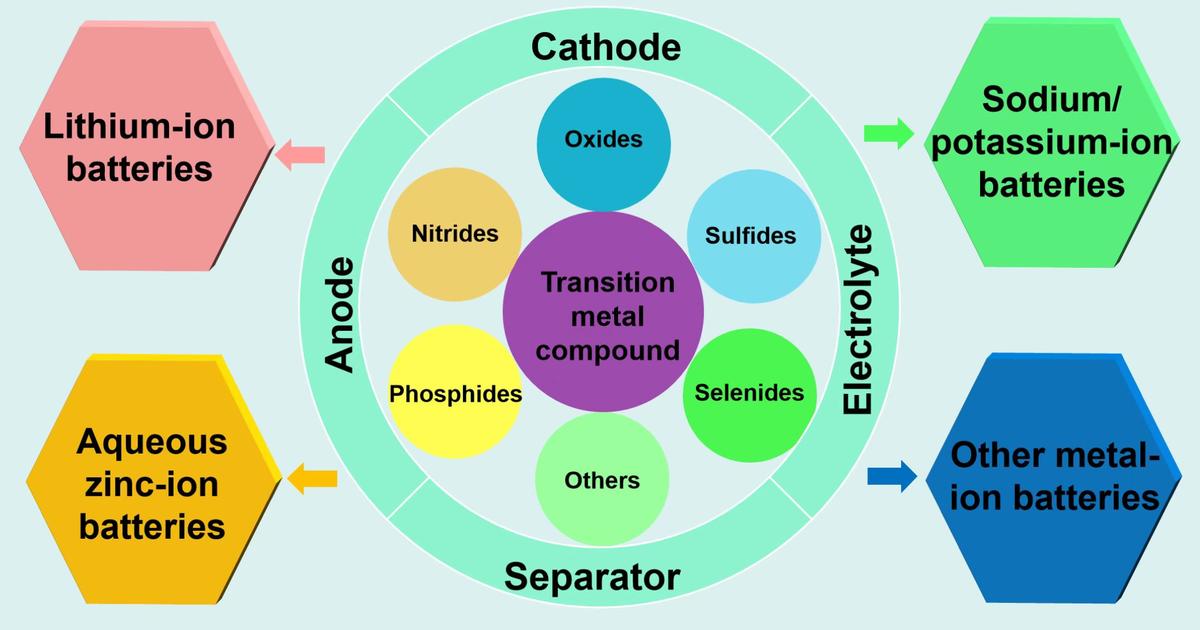Transition Metal Compound Materials for Secondary Batteries
A special issue of Batteries (ISSN 2313-0105). This special issue belongs to the section "Battery Materials and Interfaces: Anode, Cathode, Separators and Electrolytes or Others".
Deadline for manuscript submissions: closed (31 August 2023) | Viewed by 14679

Special Issue Editors
Interests: Li-ion batteries; sodium-ion batteries; MOF-derived materials; polymer electrolytes; organic electrode materials
Interests: Li-S batteries; lithium metal anode
Special Issue Information
Dear Colleagues,
At present, the safety and energy density of rechargeable batteries are vital to their widespread application in portable devices and electric vehicles. Tremendous research efforts have been devoted to improving the unbeatable performance of lithium-ion batteries at all levels. As a result, some new battery systems have emerged, including sodium-ion batteries, potassium-ion batteries, and aqueous zinc-ion batteries. It is worth noting that incremental breakthroughs essentially rely on new materials with high specific theoretical capacity and natural abundant resources.
Transition metal compounds are typical conversion-type electrode materials that were originally used in secondary battery systems. The mechanism of these materials involved in batteries was reversible conversions between the high and low valence states of metal, delivering remarkably high capacity values. Because of the unoccupied outer electron orbitals of transition metal elements, various kinds of transition metal compounds have been discovered with unique functions. The natural abundance reserves and low cost of these materials have recently attracted researchers’ extensive attention. Until now, these materials have been involved in each battery component (cathode, anode, electrolyte, separator, etc.). Design using transition metal compounds with unique nanostructure endows these materials with special functionality, which dramatically expands their practical application. It is therefore important to curate a Special Issue to collect recent advancements in conversion-type materials for batteries and to illustrate the direction of development in the future.
Potential topics include, but are not limited to:
- Transition metal compound anodes for Li/Na/K-ion batteries;
- Transition metal compound cathodes for Li/Na/K-ion batteries ;
- Transition metal compounds modified separators;
- Transition metal compounds modified lithium anode;
- Transition metal compounds modified solid-state electrolyte;
- Transition metal compound materials for aqueous Zn-ion batteries;
- Transition metal compound materials for Al/Mg/Ca-ion batteries.
Dr. Xijun Xu
Dr. Zhuosen Wang
Dr. Ling Kang
Guest Editors
Manuscript Submission Information
Manuscripts should be submitted online at www.mdpi.com by registering and logging in to this website. Once you are registered, click here to go to the submission form. Manuscripts can be submitted until the deadline. All submissions that pass pre-check are peer-reviewed. Accepted papers will be published continuously in the journal (as soon as accepted) and will be listed together on the special issue website. Research articles, review articles as well as short communications are invited. For planned papers, a title and short abstract (about 100 words) can be sent to the Editorial Office for announcement on this website.
Submitted manuscripts should not have been published previously, nor be under consideration for publication elsewhere (except conference proceedings papers). All manuscripts are thoroughly refereed through a single-blind peer-review process. A guide for authors and other relevant information for submission of manuscripts is available on the Instructions for Authors page. Batteries is an international peer-reviewed open access monthly journal published by MDPI.
Please visit the Instructions for Authors page before submitting a manuscript. The Article Processing Charge (APC) for publication in this open access journal is 2700 CHF (Swiss Francs). Submitted papers should be well formatted and use good English. Authors may use MDPI's English editing service prior to publication or during author revisions.
Keywords
- transition metal compounds
- Li/Na/K-ion batteries
- cathode
- anode
- solid-state electrolytes
- aqueous Zn-ion batteries





